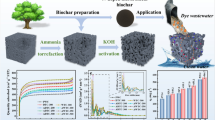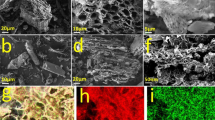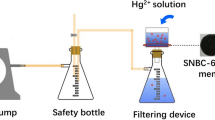Abstract
Biochar doped with heteroatom-like nitrogen could significantly improve its performance in several environmental applications. However, the preparation requires an additional nitrogen source, which influences its cost-effectiveness and impedes the practical applications. In the present study, the nitrogen self-doped biochar was prepared by using Foxtail algae (Myriophyllum aquaticum), which is a typical N-rich wetland plant as the raw material, without any modifications. Scanning electron microscopy (SEM), X-ray diffraction (XRD), and X-ray electron spectroscopy (XPS) were used to characterize the morphology and crystal structure of the material. The biochar prepared at 800 °C (MBC800) was found to have a better porous structure, large specific area (1069.08 m2g−1), and more elemental N (3.11%). Furthermore, the MBC800 was used in the persulfate-activated degradation of Acid Orange 7 (AO7; 400 mgL−1), and about 97.42% of the removal rate was observed within 60 min when the MBC800 and PS dosages (MBC800/PS) were at 0.25 gL−1 and 4 gL−1 respectively. The radical trapping results indicated that amongst the free radicals (–OH•, SO4•–, O2•–) and non-radicals (1O2), the surface-bound hydroxyl radical (–OH•) of biochar played an important role, and the non-radical singlet oxygen (1O2) played a dominant role during the AO7degradation. The study namely provides a new way for the exploitation and utilization of Foxtail algae in preparing nitrogen-doped biochar for several environmental remediation applications.








Similar content being viewed by others
Data availability
Data and materials are available upon reasonable request.
References
El-Bestawy EA, Gaber M, Shokry H, Samy M (2023) Effective degradation of atrazine by spinach-derived biochar via persulfate activation system: process optimization, mechanism, degradation pathway and application in real wastewater. Environ Res 229:115987. https://doi.org/10.1016/j.envres.2023.115987
Samy M, Gar Alalm M, Ezeldean E et al (2022) Solar-light-driven ZnO/biochar treatment of pesticides contaminated wastewater: a practical and computational study. Energy Sci Eng 10:4708–4725. https://doi.org/10.1002/ese3.1299
Tian W, Sun H, Duan X et al (2020) Biomass-derived functional porous carbons for adsorption and catalytic degradation of binary micropollutants in water. J Hazard Mater 389:121881. https://doi.org/10.1016/j.jhazmat.2019.121881
Wang L, Jiang J, Pang SY et al (2018) Oxidation of bisphenol A by nonradical activation of peroxymonosulfate in the presence of amorphous manganese dioxide. Chem Eng J 352:1004–1013. https://doi.org/10.1016/j.cej.2018.07.103
Yu J, Feng H, Tang L et al (2020) Metal-free carbon materials for persulfate-based advanced oxidation process: microstructure, property and tailoring. Prog Mater Sci 111:100654. https://doi.org/10.1016/j.pmatsci.2020.100654
Milh H, Schoenaers B, Stesmans A et al (2020) Degradation of sulfamethoxazole by heat-activated persulfate oxidation: elucidation of the degradation mechanism and influence of process parameters. Chem Eng J 379:122234. https://doi.org/10.1016/j.cej.2019.122234
Serna-Galvis EA, Ferraro F, Silva-Agredo J, Torres-Palma RA (2017) Degradation of highly consumed fluoroquinolones, penicillins and cephalosporins in distilled water and simulated hospital wastewater by UV254 and UV254/persulfate processes. Water Res 122:128–138. https://doi.org/10.1016/j.watres.2017.05.065
Nasseri S, Mahvi AH, Seyedsalehi M et al (2017) Degradation kinetics of tetracycline in aqueous solutions using peroxydisulfate activated by ultrasound irradiation: Effect of radical scavenger and water matrix. J Mol Liq 241:704–714. https://doi.org/10.1016/j.molliq.2017.05.137
Tang S, Yuan D, Rao Y et al (2018) Persulfate activation in gas phase surface discharge plasma for synergetic removal of antibiotic in water. Chem Eng J 337:446–454. https://doi.org/10.1016/j.cej.2017.12.117
Anushree C, Nanda Gopala Krishna D, Philip J (2021) Efficient dye degradation via catalytic persulfate activation using iron oxide-manganese oxide core-shell particle doped with transition metal ions. J Mol Liq 337:116429. https://doi.org/10.1016/j.molliq.2021.116429
Qiu Y, Zhang Q, Wang Z et al (2021) Degradation of anthraquinone dye reactive blue 19 using persulfate activated with Fe/Mn modified biochar: Radical/non-radical mechanisms and fixed-bed reactor study. Sci Total Environ 758:143584. https://doi.org/10.1016/j.scitotenv.2020.143584
Mustafa FS, Hama Aziz KH (2023) Heterogeneous catalytic activation of persulfate for the removal of rhodamine B and diclofenac pollutants from water using iron-impregnated biochar derived from the waste of black seed pomace. Process Saf Environ Prot 170:436–448. https://doi.org/10.1016/j.psep.2022.12.030
Mian MM, Liu G (2020) Activation of peroxymonosulfate by chemically modified sludge biochar for the removal of organic pollutants: understanding the role of active sites and mechanism. Chem Eng J 392:123681. https://doi.org/10.1016/j.cej.2019.123681
Cai S, Zhang Q, Wang Z et al (2021) Pyrrolic N-rich biochar without exogenous nitrogen doping as a functional material for bisphenol A removal: performance and mechanism. Appl Catal B Environ 291:120093. https://doi.org/10.1016/j.apcatb.2021.120093
Tian W, Lin J, Zhang H et al (2022) Kinetics and mechanism of synergistic adsorption and persulfate activation by N-doped porous carbon for antibiotics removals in single and binary solutions. J Hazard Mater 423:127083. https://doi.org/10.1016/j.jhazmat.2021.127083
Xu L, Wu C, Liu P et al (2020) Peroxymonosulfate activation by nitrogen-doped biochar from sawdust for the efficient degradation of organic pollutants. Chem Eng J 387:124065. https://doi.org/10.1016/j.cej.2020.124065
Si Z, Song X, Wang Y et al (2020) Untangling the nitrate removal pathways for a constructed wetland- sponge iron coupled system and the impacts of sponge iron on a wetland ecosystem. J Hazard Mater 393:122407. https://doi.org/10.1016/j.jhazmat.2020.122407
Ennabili A, Radoux M (2021) Nitrogen and phosphorus uptake and biomass production in four riparian plants grown in subsurface flow constructed wetlands for urban wastewater treatment. J Environ Manage 280:111806. https://doi.org/10.1016/j.jenvman.2020.111806
Yuan X, Cao Y, Li J et al (2023) Recent advancements and challenges in emerging applications of biochar-based catalysts. Biotechnol Adv 67:108181. https://doi.org/10.1016/j.biotechadv.2023.108181
Hu X, Ma LL, Liu WJ et al (2021) Microalgae biomass-derived nitrogen-enriching carbon materials as an efficient pH-universal oxygen reduction electrocatalyst for Zn-air battery. Sci Total Environ 782:146844. https://doi.org/10.1016/j.scitotenv.2021.146844
Zhu K, Wang X, Chen D et al (2019) Wood-based biochar as an excellent activator of peroxydisulfate for Acid Orange 7 decolorization. Chemosphere 231:32–40. https://doi.org/10.1016/j.chemosphere.2019.05.087
Wu Y, Guo J, Han Y et al (2018) Insights into the mechanism of persulfate activated by rice straw biochar for the degradation of aniline. Chemosphere 200:373–379. https://doi.org/10.1016/j.chemosphere.2018.02.110
Dong F, Wu L, Sun Y et al (2011) Efficient synthesis of polymeric g-C3N4 layered materials as novel efficient visible light driven photocatalysts. J Mater Chem 21:15171–15174. https://doi.org/10.1039/c1jm12844b
Cazetta AL, Zhang T, Silva TL et al (2018) Bone char-derived metal-free N- and S-co-doped nanoporous carbon and its efficient electrocatalytic activity for hydrazine oxidation. Appl Catal B Environ 225:30–39. https://doi.org/10.1016/j.apcatb.2017.11.050
Zhu K, Bin Q, Shen Y et al (2020) In-situ formed N-doped bamboo-like carbon nanotubes encapsulated with Fe nanoparticles supported by biochar as highly efficient catalyst for activation of persulfate (PS) toward degradation of organic pollutants. Chem Eng J 402:126090. https://doi.org/10.1016/j.cej.2020.126090
de Andrade JR, Vieira MGA, da Silva MGC, Wang S (2020) Oxidative degradation of pharmaceutical losartan potassium with N-doped hierarchical porous carbon and peroxymonosulfate. Chem Eng J 382:122971. https://doi.org/10.1016/j.cej.2019.122971
Zhu S, Huang X, Ma F et al (2018) Catalytic removal of aqueous contaminants on N-doped graphitic biochars: inherent roles of adsorption and nonradical mechanisms. Environ Sci Technol 52:8649–8658. https://doi.org/10.1021/acs.est.8b01817
Yang L, Xu L, Bai X, Jin P (2019) Enhanced visible-light activation of persulfate by Ti3 + self-doped TiO2/graphene nanocomposite for the rapid and efficient degradation of micropollutants in water. J Hazard Mater 365:107–117. https://doi.org/10.1016/j.jhazmat.2018.10.090
Xu Y, Lin H, Li Y, Zhang H (2017) The mechanism and efficiency of MnO2 activated persulfate process coupled with electrolysis. Sci Total Environ 609:644–654. https://doi.org/10.1016/j.scitotenv.2017.07.151
Dominguez CM, Romero A, Lorenzo D, Santos A (2020) Thermally activated persulfate for the chemical oxidation of chlorinated organic compounds in groundwater. J Environ Manage 261:110240. https://doi.org/10.1016/j.jenvman.2020.110240
Wang X, Qin Y, Zhu L, Tang H (2015) Nitrogen-doped reduced graphene oxide as a bifunctional material for removing bisphenols: synergistic effect between adsorption and catalysis. Environ Sci Technol 49:6855–6864. https://doi.org/10.1021/acs.est.5b01059
Zhao Y, Dai H, Ji J et al (2022) Resource utilization of luffa sponge to produce biochar for effective degradation of organic contaminants through persulfate activation. Sep Purif Technol 288:120650. https://doi.org/10.1016/j.seppur.2022.120650
Quan G, Zhang J, Guo J, Lan Y (2014) Removal of cr(VI) from aqueous solution by nanoscale zero-valent iron grafted on acid-activated attapulgite. Water Air Soil Pollut 225. https://doi.org/10.1007/s11270-014-1979-9
Li X, Jia Y, Zhou M et al (2020) High-efficiency degradation of organic pollutants with Fe, N co-doped biochar catalysts via persulfate activation. J Hazard Mater 397:122764. https://doi.org/10.1016/j.jhazmat.2020.122764
Han R, Fang Y, Sun P et al (2021) N-doped biochar as a new metal-free activator of peroxymonosulfate for singlet oxygen-dominated catalytic degradation of acid orange 7. Nanomaterials 11. https://doi.org/10.3390/nano11092288
He J, Xiao Y, Tang J et al (2019) Persulfate activation with sawdust biochar in aqueous solution by enhanced electron donor-transfer effect. Sci Total Environ 690:768–777. https://doi.org/10.1016/j.scitotenv.2019.07.043
An T, Yang H, Li G et al (2010) Kinetics and mechanism of advanced oxidation processes (AOPs) in degradation of ciprofloxacin in water. Appl Catal B Environ 94:288–294. https://doi.org/10.1016/j.apcatb.2009.12.002
Liu Y, Chen X, Yang Y et al (2019) Activation of persulfate with metal–organic framework-derived nitrogen-doped porous Co@C nanoboxes for highly efficient p-Chloroaniline removal. Chem Eng J 358:408–418. https://doi.org/10.1016/j.cej.2018.10.012
Yao Y, Chen H, Lian C et al (2016) Fe, Co, Ni nanocrystals encapsulated in nitrogen-doped carbon nanotubes as Fenton-like catalysts for organic pollutant removal. J Hazard Mater 314:129–139. https://doi.org/10.1016/j.jhazmat.2016.03.089
Fónagy O, Szabó-Bárdos E, Horváth O (2021) 1,4-Benzoquinone and 1,4-hydroquinone based determination of electron and superoxide radical formed in heterogeneous photocatalytic systems. J Photochem Photobiol Chem 407. https://doi.org/10.1016/j.jphotochem.2020.113057
Chen C, Ma T, Shang Y et al (2019) In-situ pyrolysis of Enteromorpha as carbocatalyst for catalytic removal of organic contaminants: considering the intrinsic N/Fe in Enteromorpha and non-radical reaction. Appl Catal B Environ 250:382–395. https://doi.org/10.1016/j.apcatb.2019.03.048
Lei Y, Chen CS, Ai J et al (2016) Selective decolorization of cationic dyes by peroxymonosulfate: non-radical mechanism and effect of chloride. RSC Adv 6:866–871. https://doi.org/10.1039/c5ra19718j
Jorfi S, Kakavandi B, Motlagh HR et al (2017) A novel combination of oxidative degradation for benzotriazole removal using TiO2 loaded on FeIIFe2IIIO4@C as an efficient activator of peroxymonosulfate. Appl Catal B Environ 219:216–230. https://doi.org/10.1016/j.apcatb.2017.07.035
Ma J, Yang Y, Jiang X et al (2018) Impacts of inorganic anions and natural organic matter on thermally activated persulfate oxidation of BTEX in water. Chemosphere 190:296–306. https://doi.org/10.1016/j.chemosphere.2017.09.148
Funding
The authors received financial support provided by the National Natural Science Foundation of China under Grant No. 51,978,001; the Collaborative Innovation Project of Anhui Universities and Colleges (GXXT-2021-057); the Open Fund of Clean Catalysis Engineering Laboratory of Anhui Province (LCCE-04); and the School-level Scientific Research Project of Anhui University of Engineering (Xjky2022170).
Author information
Authors and Affiliations
Contributions
Conceptualization and original draft writing: Xiaofan Yang; conducted experiments and writing: Jiaxu Huo; formal analysis: Siyu Du; formal analysis, writing—review and editing: Saraschandra Naraginti; writing—review and editing: Meiqing Zhu; writing—review: Ran Hong; editing: Xiaoying Zhang; writing—review and editing: Xueyu Wei; writing—review and editing: Xiaoping Xu; editing: Guanghui Xie; editing: Xiang Sun; editing: Kuppusamy Sathishkumar.
Corresponding author
Ethics declarations
Competing interests
The authors declare no competing interests.
Ethical approval
Not applicable.
Additional information
Publisher’s Note
Springer Nature remains neutral with regard to jurisdictional claims in published maps and institutional affiliations.
Rights and permissions
Springer Nature or its licensor (e.g. a society or other partner) holds exclusive rights to this article under a publishing agreement with the author(s) or other rightsholder(s); author self-archiving of the accepted manuscript version of this article is solely governed by the terms of such publishing agreement and applicable law.
About this article
Cite this article
Yang, X., Siyu, D., Huo, J. et al. Nitrogen self-doped layered porous Myriophyllum aquaticum biomass–derived biochar activated persulfate to efficiently degrade printing and dyeing wastewater. Biomass Conv. Bioref. (2024). https://doi.org/10.1007/s13399-024-05719-7
Received:
Revised:
Accepted:
Published:
DOI: https://doi.org/10.1007/s13399-024-05719-7




